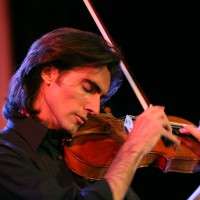|
Back
And Carpenter said, “Let There Be Light” New York
Grace Rainey Rogers Auditoirum, Metropolitan Museum of Art
04/13/2013 -
“The Dark Arts of the Viola”
Wolfgang Amadeus Mozart: Sinfonia Concertante for Violin, Viola and Orchestra, K. 364
Lera Auerbach: Sogno di Stabat Mater for Violin, Viola, Vibraphone and Orchestra
Niccolò Paganini: Sonata per la Gran Viola, MS 70
David Aaron Carpenter (Viola), Philippe Quint (Violin)
Salomé Chamber Orchestra, Sean Avram (Founder/Conductor)

D. A. Carpenter (© Aline Paley/IMG)
After last night’s performance by David Aaron Carpenter, I cannot think of a more ignominious title than the Met Museum’s “Dark Arts of the Viola”. From the highest notes of his rare 18th Century viola from the Met’s Sau-Wing Lam Collection of Rare Italian Stringed Instruments to the luscious alto melodies against the soaring violin in Mozart’s Sinfonia Concertante, Mr. Carpenter, like God, turned “dark” into heavenly light.
In terms of interesting music, the first two works on the program were more inspiring. But the display of Mr. Carpenter’s dazzling gifts was given to Niccolò Paganini, the demonic string master whose name has been besmirched with the viola. Commissioning Hector Berlioz to write him a viola concerto, the Frenchman composed Harold in Italy, and Paganini rejected it.
“Not enough fireworks,” he said.
Well, his Grand Sonata for Viola and Orchestra showed where his heart and fingers were. Not that one could find where Mr. Carpenter’s fingers were. This was typical for Paganini. A slow introduction, a pleasant song–and then variations which showed every facet in the viola-player’s repertory. Mr. Carpenter basically danced through the work, perhaps unconsciously imitating the composer, who reportedly never stopped moving for a moment on the stage. Every run up and down the scale, with high notes treading upon the violin’s highest range, every pizzicato trick, was on exhibition, and Mr. Carpenter simply let his fingers and body play their acrobatics with–what seemed to be–unnerving insouciance.
This was a mighty change from the first notes of the evening. Mr. Carpenter, not only a virtuoso in his own right, is a co-founder or the Salomé Chamber Orchestra, a youthful group of predominantly female players (though all the players have been chosen from Juilliard, Curtis, Princeton and other schools). The violins and violas stood around the soloists, but alas, were not quite up to the standards of the work.
That is, this group was a bit stodgy, starting with little of the energy needed for such an enchanting Mozart work. Perhaps it was because there were two concertmasters leading them. At times, Mr. Carpenter cued them on, at other times violinist Philippe Quint turned to bring them in.
Fortunately, after the first lackadaisical initial minutes, the group and soloists turned the excitement of the music.

P. Quint (© Lisa Marie Mazzucco)
For that, the Russian-born Juilliard-trained Mr. Quint was a fiery partner for Mr. Carpenter in the first movement. But it was the Andante, where the pair played a movement so utterly poignant that all else was forgotten. Had Mozart perhaps read the score of Bach’s Concerto for Two Violins before writing this? The same overlapping notes, the same canons drifting into their own melodies as the Bach. But Mozart, who loved, above all, the low registers of the clarinet, gave these same ravishing notes to the viola, and Mr. Carpenter gave them all the passion necessary.
The middle work was Lera Auerbach’s brilliant Dreams of Stabat Mater, based on themes of Giovanni Pergolesi’s work. After a fairly dissonant introduction, Ms. Auerbach started with the first theme of the original, continuing with other notes–sometimes hidden, sometimes blatant–varying the moods from pure Baroque to a translation of tasteful 20th Century harmonies.
But what stood out for me were the most beautiful timbres of the work. A resonant vibraphone gave the mysterious backgrounds when necessary. At other times, we had a melodious solo violin against pizzicati on the viola against the vibraphone giving a bell-like aura. The blends with the orchestra itself painted a tapestry vaguely ecclesiastical, with whispers of the 18th Century, mutations into our own times.
Both Mr. Quint, performing on the “Bavarian” Stradivarius, and violinist Sean Carpenter (another founder of the orchestra) on the “Baltic” Guarneri del Gesù of 1731, had the splendid color to make Ms. Auerbach’s work equally beautiful and beatific.
Harry Rolnick
|